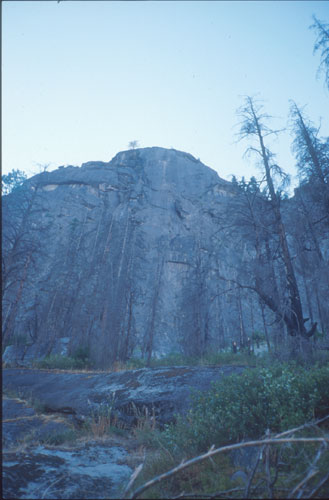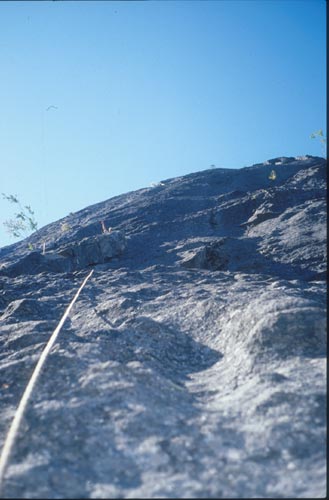Outer Space

The Snow Creek Wall.
I met Chris Carleston, a new climbing partner, at his place and we drove out to Leavenworth for some mid-week climbing. I had wanted to do Outer Space for a while, but the hoard of weekend climbers was always a turnoff. Finally, having some time during the week, and a willing partner, it was time to do it. The hike in was pretty short, only an hour or so, and the trail was great except right below the climb. There seem to be many ways to start the climb, all of which lead to two tree ledge. We weren't sure what to do, but seeing as the upper pitches sound the best, we chose a dihedral off to the right. In retrospect, the start mentioned in Nelson's guide (5.8 traverse on flake) looks pretty nice and straitforeward.

Looking down the first pitch.
I lead up the easy looking dihedral which soon turned to mid-5th class. The climbing was enjoyable on clean rock with good pro; a great warm up pitch! We streched the 60 meter rope for about 20 feet extra before I found a great ledge to belay from. As it turns out, I had belayed too high. We were 20 ft or so above the bolted anchor noted on Smoot's topo. Doh! So Chris lead off on the traverse pitch. Still climbing in his tennis shoes, I figured it couldn't be too bad. He eventually ran out of rope, so I took apart the anchor and started simu-climbing again. When I came around the corner onto the traverse, I wasn't too excited about what I saw. There was one piece about 5 feet away, and then 80-100 ft or so of unprotected horizontal rope. This would have been fine except for I had to downclimb a 20 ft section of 5.7 friction-stemming before crossing the 4th class ledges. Luckily it went off fine, and we continued climbing until he had reached the far end of two tree ledge.

The infamous traverse pitch.
It was my lead again, and Chris was psyching me up to jump on the crux pitch. I hadn't heard much about this pitch other than a friend of a friend who peeled from the traverse and had to prussik back up the rope! I clipped into the fixed bong on the initial 5.9 lieback and then made the moves up pretty easily. I then followed the obvious cracks of the corner system above until I was peering around from under a roof at the traverse. I tried to get some gear in around the corner, but the cracks were all flared and wierd. I settled for a chock at waist level and pulled around the corner and on to some awkward 5.9. The moves weren't as bad as I had expected, and there always was a good foot hold in sight. I clipped a solid looking pin, and a fixed friend and before I knew it I was placing a piece below the final wall up to the belay. I didn't recognize this as such, however, and so continued traversing around a corner and across a finger traverse to a block below a roof. The route finding error made the ropedrag horrendous so I set a semi-hanging belay and brought Chris up.

Chickenheads attack! Why put any pro in for the 60 feet or so anyhow?
(Chris on top of the Pedastal)
Once we had moved the belay 10 feet higher onto the ledge above, Chris lead off on some nice runout knobbs. This pitch was a lot of fun, and gave a small hint of what lay higher up on the headwall above. As I joined him on top of the Pedastal, I got my first look at the awesome crack pitches leading up the "shield" of the Snow creek wall. Wow! I quickly re-racked the gear, and then started up the pitch on some knobs left of the start of the crack. Once into the crack, it starts small--about finger sized for 20 feet or so. Above that, while using the chickenheads for feet, the crack soars vertically upward for about 120 feet of perfect hands! The pitch was pretty long, but unbelievably enjoyable, though I was glad to have brought 3 hand crack size cams.

Chris following the first crack pitch.

... and he makes it to "library ledge".
The sun had just left us after I had finished my lead. Chris decided that the finger crack start to the last pitch looked better than a flaring flake bypass, and he lead up the nice 5.9 jamming. Again, the 60 meter rope came in handy. The topo says 160ft for this pitch, but the optimal belay seemed to come at 5 feet short of my tie in. The second pitch was great jamming with a bit more varriety of crack sizes and crazy chickenheads all over the place.

Dave coming up the last bit of the 7th pitch.
As it is sort of noted on the topos, there is one last little bit to surmount before you reach the top of the wall. I slung a unusually fat knob, and then pulled up the short steep wall to the sunshine and flat ground above. yeehaw, what a route!

Dave getting creative with his pro.
I brought Chris up, and he changed into his running shoes while I coiled up the rope. I had decided not to bring my lightweight boots up the climb because they were too bulky... a painful choice as I was to find out! The descent is straitforeward, initially following a narrow gully down. We made a short rappell from a slung block, but noticed that it would be possible to down climb around the overhand on the decender's right. Below this we just followed the paths down, and then cut to the left across slabs farther down. There were some nasty kicking-rock-on-your-partner places, but over not unlike most cascade descents. We traversed high left, and found ourselves at another rap station off a tree root. one last short rappell brought us down to the trail, and we hiked back to the base.
This route is excellent, and well deserving of its reputation. I would say that every climber in washington should do this route... but I won't because then it'll be even more crowded! ;)
We used the great topo for Outer Space from Jeff Smoot's site, www.climbingwashington.com.